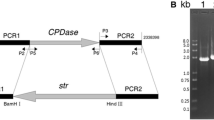Abstract
Aphidicolin is a specific inhibitor of DNA polymerase α and blocks DNA synthesis in vivo. The inhibition of purified α-polymerase has been shown to be competitive with dCTP but not with the other three deoxynucleoside triphosphates (dNTPs). In order to study the various roles that the α-polymerase might play in DNA replication and/or repair, we have attempted to isolate Chinese hamster V79 cells that are resistant to aphidicolin. Four resistant mutants were isolated from BrdU-black light- and UV-mutagenized cells. None of the mutants isolated contains an α-polymerase that is resistant, in crude extract measurements, to aphidicolin. Three mutants isolated, however, were found to be resistant to araC. Two mutants tested were found to be sensitive to cytidine and have elevated levels of dCTP or all 4 dNTPs. These results indicate that they are nucleotide pool mutants instead of α-polymerase mutants. One mutant, aphr-4, is characterized by the following: (1) high level of dCTP; (2) thymidine (or CdR, UdR, auxotrophic; (3) sensitive to thymidine (and AdR, GdR); (4) slow-growing; (5) cytidine sensitive; (6) UV sensitive and hypermutable at the ouabain-resistant locus; and (7) a ninefold increase in frequency of chromatid gaps and breaks when cells are exposed to BrdU- containing medium. Revertants of aphr-4 which are partially aphidicolin-resistant and retain the first three characteristics listed above, but not the others, have been isolated. The appearance of this type of revertant indicates that either aphr- 4 or its “revertant” is a double mutant.
Similar content being viewed by others
Literature cited
Brundret, K.M., Dalziel, W., Hesp, B., Jarvis, J.A.J., and Neidle, S. (1972).J. Chem. Soc. D. Chem. Commun. 1027–1028.
Bucknall, R.A., Moores, H., Simms, R., and Hesp, B. (1973).Antimicrob. Ag. Chemother. 4:294–298.
Longiaru, M., Ikeda, J.E., Jarkovsky, Z., Horwitz, S.B., and Horwitz, M.S. (1979).Nucleic Acids Res. 6:3369–3386.
Habara, A., Kano, K., Nagano, H., Mano, Y., Ikegami, S., and Yamashita, T. (1980).Biochem. Biophys. Res. Commun. 92:8–12.
Pedrali-Noy, G., and Spadari, S. (1979).Biochem. Biophys. Res. Commun. 88:1194–1202.
McLennan, A.G. (1980).Biochem. Biophys. Res. Commun. 94:116–122.
Ikegami, S., Taguchi, T., Ohashi, M., Oguro, M., Nagano, H., and Mano, Y. (1978).Nature 275:458–460.
Wist, E. (1980).Experientia 36:405.
Hanaoka, F., Kato, H., Ikegami, S., Ohashi, M., and Yamado, M. (1979).Biochem. Biophys. Res. Commun. 87:575–580.
Ohashi, M., Tagushi, T., and Ikegami, S. (1978).Biochem. Biophys. Res. Commun. 82:1084–1090.
Oguro, M., Suzuki-Hori, C., Nagano, H., Mano, Y., and Ikegami, S. (1979).Eur. J. Biochem. 97:603–607.
Wist, E., and Prydz, H. (1979).Nucleic Acids Res. 6:1583–1590.
Oguro, M., Shioda, M., Nagano, H., and Mano, Y. (1980).Biochem. Biophys. Res. Commun. 92:13–19.
Ikegami, S., Kawada, K., Kimura, Y., and Suzuki, A. (1979).Agric. Biol. Chem. 43:161–166.
Berger, N.A., Kurohara, K.K., Petzold, S.J., and Sikorski, G.W. (1979).Biochem. Biophys. Res. Commun. 89:218–225.
Ayusawa, D., Iwata, K., Kozu, T., Ikegami, S., and Seno, T. (1979).Biochem. Biophys. Res. Commun. 91:946–954.
Nishimura, M., Yasuda, H., Ikegami, S., Ohashi, M., and Yamada, M. (1979).Biochem. Biophys. Res. Commun. 91:939–945.
Ford, D.K., and Yerganian, G. (1958).J. Natl. Cancer Inst. 2:393–425.
Carter, G. (1979). InDiagnostic Procedures in Veterinary Microbiology, (Charles C Thomas, Springfield, Illinois), pp. 187–197.
Eagle, H. (1959).Science 130:432–437.
Chu, E.H.Y., Sun, N.C., and Chang, C.C. (1972).Proc. Natl. Acad. Sci. U.S.A. 69:3459–3463.
Perry, P., and Wolff, S. (1974).Nature 251:156–158.
Chang, C.C., Trosko, J.E., and Akera, T. (1978).Mutat. Res. 51:85–98.
Sabourin, C.L.K., Reno, J.M., and Boezi, J.A. (1978).Arch. Biochem. Biophys. 187:96–101.
Lindberg, U., and Skoog, L. (1970).Anal. Biochem. 34:152–160.
Skoog, L. (1970).Eur. J. Biochem. 17: 202–208.
Giles, K.W., and Myers, A. (1965).Nature 206:93.
Meuth, M., Trudel, M., and Siminovitch, L. (1979).Somat. Cell Genet. 5:303–318.
Robert de Saint Vincent, B., and Buttin, G. (1979).Somat. Cell Genet. 5:67–82.
Rogers, A.M., Hill, R., Lehmann, A.R., Arlett, C.F., and Burns, V.W. (1980).Mutat. Res. 69:139–148.
Meuth, M., and Green, H. (1974).Cell 3:367–374.
Robert de Saint Vincent, B., Dechamps, M., and Buttin, G. (1980).J. Biol. Chem. 255:162–167.
Reichard, P., Canellakis, Z.N., and Canellakis, E.S. (1961).J. Biol. Chem. 236:2514–2519.
Meuth, M., Aufreiter, E., and Reichard, P. (1976).Eur. J. Biochem. 71:39–43.
Moore, E.C., and Hurlbert, R.B. (1966).J. Biol. Chem. 241:4802–4809.
Meuth, M., L'Heureux-Huard, N., and Trudel, M. (1979).Proc. Natl. Acad. Sci. U.S.A. 76:6505–6509.
Sutherland, G.R., Baker, E., and Seshadri, R.S. (1980).Am. J. Hum. Genet. 32:542–548.
Hsu, T.C., and Somers, C.E. (1961).Proc. Natl. Acad. Sci. U.S.A. 47:396–403.
Author information
Authors and Affiliations
Rights and permissions
About this article
Cite this article
Chang, CC., Boezi, J.A., Warren, S.T. et al. Isolation and characterization of a UV-sensitive hypermutable aphidicolin-resistant Chinese hamster cell line. Somat Cell Mol Genet 7, 235–253 (1982). https://doi.org/10.1007/BF01567660
Received:
Revised:
Issue Date:
DOI: https://doi.org/10.1007/BF01567660




